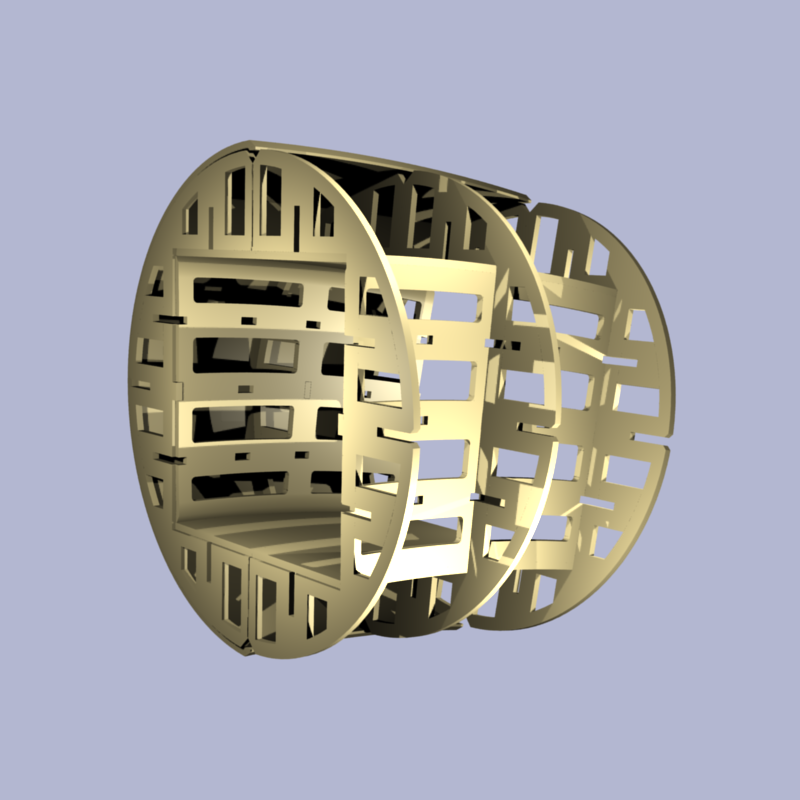Toroids with Wing-Like Internal Structure.
-
Billy Catringer
- Posts: 221
- Joined: Mon Feb 02, 2009 2:32 pm
- Location: Texas
I revised the ribs on this thing yesterday and finally made meshes with as many holes as possible to render properly. I am going to revise it all again today because now I am convinced that Aluminum 5083-O will work in this location, but I will have to make the internal members thicker. They have to be thick enough to hold the magnets in place and that is it. The cold water jacket will be the rigid bridge between the supports. Will use Aluminum 5083-O for the LN2 jacket as well.
5083-O is commonly used as a support material in superconducting magnets. It's lower mass is an obvious advantage, but its main virtue is that it shrinks at the about the same rate as copper at cryogenic temperatures. It also becomes slightly stronger and low temps.
It is a work hardened material in which its strength holds up fairly well to welding, unlike most of the other high strength Aluminum alloys. The tubes will have to be cold forged, but finding an outfit to make our pieces should not be that hard for this material.
5083-O is commonly used as a support material in superconducting magnets. It's lower mass is an obvious advantage, but its main virtue is that it shrinks at the about the same rate as copper at cryogenic temperatures. It also becomes slightly stronger and low temps.
It is a work hardened material in which its strength holds up fairly well to welding, unlike most of the other high strength Aluminum alloys. The tubes will have to be cold forged, but finding an outfit to make our pieces should not be that hard for this material.
-
KeithChard
- Posts: 41
- Joined: Tue Jul 08, 2008 9:16 pm
- Location: Banff,Scotland
Candidate alloy for high temperature water shell (first wall)?
http://www.atlasbronze.com/C95800_properties.html
Thermal expansion/permeability combination is the best I have been able to find.
This is another possibility.
http://cat.inist.fr/?aModele=afficheN&cpsidt=2647087
It's a pity Invar could not be used, or would it be OK in the high field strength because it would saturate?
http://www.atlasbronze.com/C95800_properties.html
Thermal expansion/permeability combination is the best I have been able to find.
This is another possibility.
http://cat.inist.fr/?aModele=afficheN&cpsidt=2647087
It's a pity Invar could not be used, or would it be OK in the high field strength because it would saturate?
Keith
-
Billy Catringer
- Posts: 221
- Joined: Mon Feb 02, 2009 2:32 pm
- Location: Texas
-
Billy Catringer
- Posts: 221
- Joined: Mon Feb 02, 2009 2:32 pm
- Location: Texas
Changed the material to Aluminum 5083-O. This called for thicker ribs and spars. Finally figured out an efficient way to make meshes with holes in Blender. Let's see, I have twelve pieces left to do and some modifications to two of the pieces shown in this picture. Also, I finally doped out a assembly/welding sequence. Will have to do some plug welding, which I don't like, but it cannot be avoided.


-
Billy Catringer
- Posts: 221
- Joined: Mon Feb 02, 2009 2:32 pm
- Location: Texas
-
KeithChard
- Posts: 41
- Joined: Tue Jul 08, 2008 9:16 pm
- Location: Banff,Scotland
-
Billy Catringer
- Posts: 221
- Joined: Mon Feb 02, 2009 2:32 pm
- Location: Texas
Jccarlton wrote:Your planning on wire EDM, right. You have to remember to take temperature compensation effects into account. Also plan for some kind of pressure relief in the system in case the N2 boils(not a good thing.)
This is basically my best guess based on what I know. Right now I don't know if we'll be installing Bitter Plates or SC Tape. I am hoping for Bitter Plates as I think they would hold up to the mechanical loads. I am not so certain about the SC tape. This particular grade of aluminum (5083-O) has a coefficient of expansion that is very close to that of copper so the relative size between the structure and the core should remain the same.
-
Billy Catringer
- Posts: 221
- Joined: Mon Feb 02, 2009 2:32 pm
- Location: Texas
-
Billy Catringer
- Posts: 221
- Joined: Mon Feb 02, 2009 2:32 pm
- Location: Texas
dweigert wrote:I have a concern with the possible turbulence in the coolant. How fast is the LHe supposed to be pumped through this? Lots of sharp edges to form vorticies with...
With good reason. While turbulence helps a great deal with heat exchange, it also causes an increase in head at the pumps. There are also two other major worries that we must test for prior to building the magnet. One is vibration. That could cause us serious trouble throughout the reactor. The next one is cavitation. Cavitation would eat up the supporting structure in a distressingly short period of time.
The cheap HV power supply guys use a nozzle that is open to keep the fluids moving.Billy Catringer wrote:dweigert wrote:I have a concern with the possible turbulence in the coolant. How fast is the LHe supposed to be pumped through this? Lots of sharp edges to form vorticies with...
With good reason. While turbulence helps a great deal with heat exchange, it also causes an increase in head at the pumps. There are also two other major worries that we must test for prior to building the magnet. One is vibration. That could cause us serious trouble throughout the reactor. The next one is cavitation. Cavitation would eat up the supporting structure in a distressingly short period of time.

http://www.divtecs.com/
Engineering is the art of making what you want from what you can get at a profit.
-
KeithChard
- Posts: 41
- Joined: Tue Jul 08, 2008 9:16 pm
- Location: Banff,Scotland
-
KeithChard
- Posts: 41
- Joined: Tue Jul 08, 2008 9:16 pm
- Location: Banff,Scotland